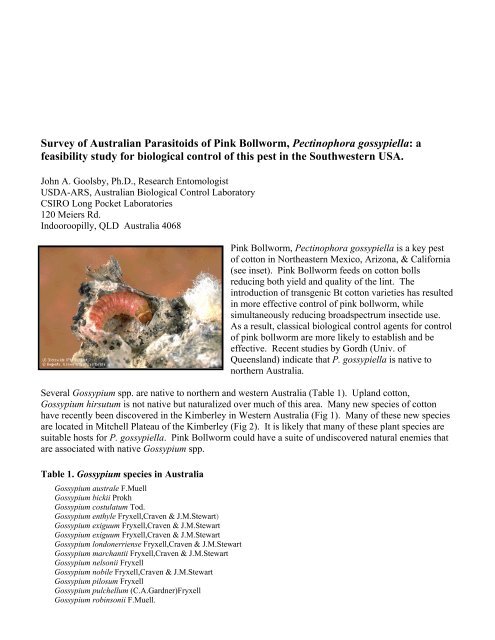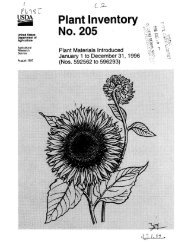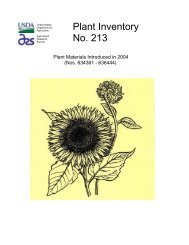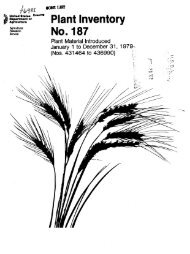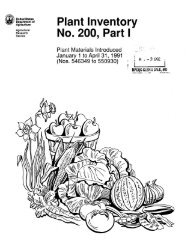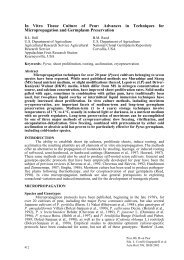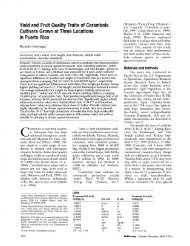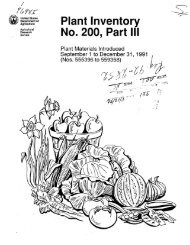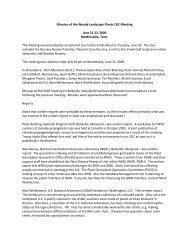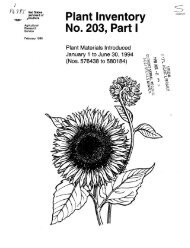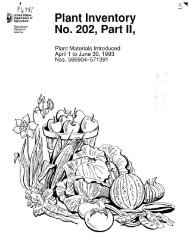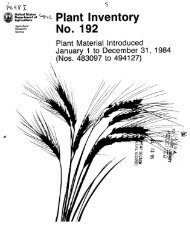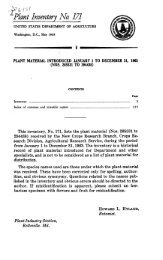Survey of Australian Parasitoids of Pink Bollworm, Pectinophora ...
Survey of Australian Parasitoids of Pink Bollworm, Pectinophora ...
Survey of Australian Parasitoids of Pink Bollworm, Pectinophora ...
Create successful ePaper yourself
Turn your PDF publications into a flip-book with our unique Google optimized e-Paper software.
<strong>Survey</strong> <strong>of</strong> <strong>Australian</strong> <strong>Parasitoids</strong> <strong>of</strong> <strong>Pink</strong> <strong>Bollworm</strong>, <strong>Pectinophora</strong> gossypiella: a<br />
feasibility study for biological control <strong>of</strong> this pest in the Southwestern USA.<br />
John A. Goolsby, Ph.D., Research Entomologist<br />
USDA-ARS, <strong>Australian</strong> Biological Control Laboratory<br />
CSIRO Long Pocket Laboratories<br />
120 Meiers Rd.<br />
Indooroopilly, QLD Australia 4068<br />
<strong>Pink</strong> <strong>Bollworm</strong>, <strong>Pectinophora</strong> gossypiella is a key pest<br />
<strong>of</strong> cotton in Northeastern Mexico, Arizona, & California<br />
(see inset). <strong>Pink</strong> <strong>Bollworm</strong> feeds on cotton bolls<br />
reducing both yield and quality <strong>of</strong> the lint. The<br />
introduction <strong>of</strong> transgenic Bt cotton varieties has resulted<br />
in more effective control <strong>of</strong> pink bollworm, while<br />
simultaneously reducing broadspectrum insectide use.<br />
As a result, classical biological control agents for control<br />
<strong>of</strong> pink bollworm are more likely to establish and be<br />
effective. Recent studies by Gordh (Univ. <strong>of</strong><br />
Queensland) indicate that P. gossypiella is native to<br />
northern Australia.<br />
Several Gossypium spp. are native to northern and western Australia (Table 1). Upland cotton,<br />
Gossypium hirsutum is not native but naturalized over much <strong>of</strong> this area. Many new species <strong>of</strong> cotton<br />
have recently been discovered in the Kimberley in Western Australia (Fig 1). Many <strong>of</strong> these new species<br />
are located in Mitchell Plateau <strong>of</strong> the Kimberley (Fig 2). It is likely that many <strong>of</strong> these plant species are<br />
suitable hosts for P. gossypiella. <strong>Pink</strong> <strong>Bollworm</strong> could have a suite <strong>of</strong> undiscovered natural enemies that<br />
are associated with native Gossypium spp.<br />
Table 1. Gossypium species in Australia<br />
Gossypium australe F.Muell<br />
Gossypium bickii Prokh<br />
Gossypium costulatum Tod.<br />
Gossypium enthyle Fryxell,Craven & J.M.Stewart)<br />
Gossypium exiguum Fryxell,Craven & J.M.Stewart<br />
Gossypium exiguum Fryxell,Craven & J.M.Stewart<br />
Gossypium londonerriense Fryxell,Craven & J.M.Stewart<br />
Gossypium marchantii Fryxell,Craven & J.M.Stewart<br />
Gossypium nelsonii Fryxell<br />
Gossypium nobile Fryxell,Craven & J.M.Stewart<br />
Gossypium pilosum Fryxell<br />
Gossypium pulchellum (C.A.Gardner)Fryxell<br />
Gossypium robinsonii F.Muell.
2<br />
Gossypium rotundifolium Fryxell,Craven & J.M.Stewart<br />
Gossypium sturtianum J.H.Willis<br />
Gossypium australe, Darwin, NT<br />
Gossypium rotundifolia, Broome, WA<br />
Gossypium sturtiantum, Exmouth, WA<br />
G. hirsutum as green mulch, Kununura, WA<br />
Gossypium australe, Chichester, WA<br />
Goolsby & Sands, feral cotton, Woolner Station, NT<br />
Fig. 1. Gossypium species in northern Australia that are hosts <strong>of</strong> pink bollworm, <strong>Pectinophora</strong> gossypiella.
3<br />
DARWIN<br />
Mitchell Plateau<br />
KIMBERLEY<br />
PILBARA<br />
Fig 2. Map <strong>of</strong> Australia showing major collecting areas in red.<br />
Preliminary field surveys <strong>of</strong> the parasitoid complex attacking P. gossypiella were conducted in Northern<br />
Australia. Four surveys were conducted in 2000-01. In October 2000 John Goolsby, Don Sands (CSIRO)<br />
collected from feral cotton and wild hosts and in the Darwin and Kimberley regions. Dr. Sands had<br />
conducted a similar study in the 1970’s for the University <strong>of</strong> California. Mr. Graham Schultz (Northern<br />
Territory DPI, Darwin) traveled with us to several known sites with feral cotton. Mr. Schultz has<br />
continued to the feral cotton and makes shipments <strong>of</strong> infested cotton bolls to ABCL for evaluation. In<br />
July 2000 John Goolsby and Alan Kirk (EBCL) surveyed sites in Darwin and Kimberley and across to<br />
Broome in northwest Australia. This survey focused on wild hosts including many <strong>of</strong> the indigenous<br />
Gossypium species. We were aided by Roweena Eastick (CSIRO Cotton CRC, Kununurra, WA) who<br />
monitors the indigenous Gossypium spp. for potential hybrids with transgenic cotton. In February 2001
4<br />
John Goolsby and Ryan Zonneveld surveyed the Kimberley and Darwin Region during the monsoon<br />
season. <strong>Pectinophora</strong> gossypiella populations peak during this time as many <strong>of</strong> the wild host plants are<br />
flowering. In Kununurra, WA we collected hundreds <strong>of</strong> P. gossypiella from cotton being grown through<br />
the summer as a green mulch. It is unusual to find cotton during this time <strong>of</strong> year because commercial<br />
cotton production has shifted to a winter growing season to avoid pest pressure. Cotton grown in the<br />
summer monsoon season represents an excellent opportunity to survey and recover parasitoids <strong>of</strong> P.<br />
gossypiella. We were aided in Kununurra by John Moulden, Kimberley Entomologist with Western<br />
Australia Agriculture. Mr. Moulden and his colleague Amanda Annells provide research and extension<br />
services to local growers and are interested in future collaboration that involves cotton pests. In May<br />
2001, John Goolsby and Alan Kirk surveyed the Pilbara region. Several Gossypium species occur in this<br />
area including several native species such as G. australe, G. rotundifolia, and G. sturtiantum. Each<br />
species flowers at different times <strong>of</strong> the year providing a succession <strong>of</strong> suitable hosts for P. gossypiella.<br />
In summary, Gossypium hirsutum and its native congeners occur across a wide range <strong>of</strong> habitats and<br />
climates in Australia. Quarterly sampling would be needed to target flowering and boll set for each<br />
species.<br />
The target, P. gossypiella occurs over this entire range moving between wild and feral hosts, but reaching<br />
highest densities on G. hirsutum. Several species <strong>of</strong> parasitoids are associated with P. gossypiella with a<br />
wide range <strong>of</strong> biologies (Table 2). It is likely that some species attack early larval instars and emerge<br />
from late larvae or pupae. Many larvae fall to the ground and pupate. We did not sample pupae in the<br />
soil, but expect there would be another suite <strong>of</strong> parasitoids that attack this stage <strong>of</strong> the pest. Host<br />
exposures at or below the soil surface would be best for sampling parasitoids with this type <strong>of</strong> biology.<br />
Table 2. Parasitoid reared from pink bollworm in Australia<br />
Host Plant Host Insect Parasitoid Location<br />
Gossypium hirsutum Pectinophroa gossypiella Apantales nr. oenone Kununura, WA<br />
Gossypium australe Pectinophroa gossypiella<br />
Gossypium hirsutum Pectinophroa gossypiella Apantales sp. novum Darwin, NT<br />
Gossypium hirsutum Pectinophroa gossypiella Brachymeria sp. Woolner Station, NT<br />
Understanding the biology <strong>of</strong> the parasitoids is critical to predicting their impact in the cotton agroecosystem.<br />
Another aspect <strong>of</strong> biology that should be investigated is host range. Only parasitoids with a<br />
narrow field host range should be considered in a biological control program. A unique opportunity is<br />
available to study field host range <strong>of</strong> the parasitoids attacking P. gossypiella. A related gelechiid moth,<br />
Evippe sp. originally collected from Mesquite, Propospis sp. in the Argentina has been released in<br />
northern Australia in the same habitat as P. gossypiella. By surveying the parasitoids on both the native<br />
and introduced gelechiid moths we can learn a great deal about their host ranges. Evippe species in North<br />
America would be a critical non-target species if an <strong>Australian</strong> parasitoid was released in the<br />
southwestern U.S. ‘mesquite belt’.<br />
Dr. Steve Naranjo and Dr. John Goolsby met in August at the Practice <strong>of</strong> Biological Control Symposium<br />
to discuss future prospects for the research program. It was proposed that future research should entail<br />
both field and laboratory studies. Fieldwork would involve continued exploration for <strong>Pectinophora</strong><br />
parasitoids in the Darwin, Kimberley and Pilbara regions. Field research would also include an<br />
assessment <strong>of</strong> field host range for the common parasitoids. Laboratory research would focus on the<br />
biology <strong>of</strong> the key parasitoid species. Standard artificial diets would be used to rear the <strong>Pectinophora</strong><br />
scutigera and/or P. gossypiella used in the biological studies <strong>of</strong> the parasitoid. Evaluation would focus on<br />
the ability <strong>of</strong> Apantales sp. and other candidate parasitoid species to parasitize both early instars <strong>of</strong> P.
5<br />
gossypiella on the surface <strong>of</strong> the boll and/or latter instars that have tunneled inside. (<strong>Parasitoids</strong> with this<br />
type <strong>of</strong> biology would be most suited to the cotton agroecosystem in southwestern U.S.) Parasitoid<br />
species that target the correct host stage and have a sufficiently narrow host range would be forwarded to<br />
collaborators in the US for final quarantine screening and field release. Further research is contingent<br />
upon funding.<br />
Appendix<br />
<strong>Survey</strong> Records for <strong>Pectinophora</strong> program<br />
Coll. # Date Host Site State Country<br />
2000854 7/20/2000 Hsp Berimbah NT AUSTRALIA<br />
2000855 7/21/2000 Hsp<br />
18 12th St. and Anzac Mem,<br />
Katherine<br />
NT AUSTRALIA<br />
2000856 7/21/2000 Hsp Timber Creek NT AUSTRALIA<br />
2000857 7/25/2000 Hsp 60km E Fitzory Crossing WA AUSTRALIA<br />
2000858 7/25/2000 Hsp 260 Flynn St WA AUSTRALIA<br />
2000859 7/24/2000 Hsp Hall's Creek WA AUSTRALIA<br />
2000860 7/25/2000 Hsp Derby WA AUSTRALIA<br />
2000861 7/25/2000 Gau Derby WA AUSTRALIA<br />
2000862 7/26/2000 Hrs Short St WA AUSTRALIA<br />
2000863 7/26/2000 Grt Barred Creek WA AUSTRALIA<br />
2000864 7/26/2000 Hpn Willie Creek WA AUSTRALIA<br />
2000865 7/27/2000 Gau Thangoo WA AUSTRALIA<br />
2000866 7/27/2000 Hpn Cape Latouche Treville WA AUSTRALIA<br />
2000867 7/27/2000 Gau<br />
10km inland from Cape Latouche<br />
Treville<br />
WA AUSTRALIA<br />
2000874 8/20/2000 Ghr Douglas River NT AUSTRALIA<br />
2000875 8/20/2000 Ghr Douglas River NT AUSTRALIA<br />
2000876 8/20/2000 Ghr Beatrice Hill NT AUSTRALIA<br />
2000877 8/20/2000 Ghr Woolner Station NT AUSTRALIA<br />
2000878 8/20/2000 Ghr Woolner Station NT AUSTRALIA<br />
2000879 8/18/2000 Ghr East Arm Point NT AUSTRALIA<br />
2000880 8/21/2000 Ghr Elsey Station NT AUSTRALIA<br />
2000881 8/21/2000 Ghr Elsey Station NT AUSTRALIA<br />
2000882 8/14/2000 Ghr Bowen Strait NT AUSTRALIA<br />
2000883 8/14/2000 Ghr Smith Point NT AUSTRALIA<br />
2000884 8/24/2000 Hrs Timber Creek NT AUSTRALIA<br />
2000891 10/7/2000 Htl Durack, WA Ag. Station WA AUSTRALIA<br />
2000892 10/8/2000 Hsp Ivanhoe Falls WA AUSTRALIA<br />
2000893 10/8/2000 Gau Kununura WA AUSTRALIA<br />
2000894 10/9/2000 Hrs Timber Creek NT AUSTRALIA<br />
2000895 10/9/2000 Gau East <strong>of</strong> Timber Creek NT AUSTRALIA<br />
2000896 10/11/2000 Ghr Elsey Station NT AUSTRALIA<br />
2000897 10/11/2000 Ghr Daly River NT AUSTRALIA<br />
2000898 10/11/2000 Ghr Woolner Station NT AUSTRALIA<br />
2000899 10/11/2000 Ghr Lee's Point NT AUSTRALIA<br />
2001806 2/26/2001 Hsp Kununura WA AUSTRALIA<br />
2001807 2/26/2001 Ghr Packsaddle WA AUSTRALIA
6<br />
2001808 2/26/2001 MALV The Grotto WA AUSTRALIA<br />
2001809 2/27/2001 Ghr Packsaddle WA AUSTRALIA<br />
2001810 2/28/2001 Ghr Woolner Station NT AUSTRALIA<br />
2001811 3/1/2001 Ghr Elsey Station NT AUSTRALIA<br />
2001812 3/1/2001 Hpn Salt Creek NT AUSTRALIA<br />
2001813 3/1/2001 Gau Salt Creek NT AUSTRALIA<br />
2001814 3/2/2001 Ghr Lee's Point NT AUSTRALIA<br />
2001815 3/2/2001 Hrs 9 Pinehurst St. NT AUSTRALIA<br />
2001828 5/2/2001 TAap Geraldton WA AUSTRALIA<br />
2001829 5/3/2001 ARdo 440 Roadhouse WA AUSTRALIA<br />
2001830 5/5/2001 UNDET Murchison WA AUSTRALIA<br />
2001831 5/4/2001 ARdo Carnarvon Caravan Park WA AUSTRALIA<br />
2001832 5/4/2001 ABlp 50 km E Carnarvon WA AUSTRALIA<br />
2001833 5/4/2001 UNDET Ashburton River WA AUSTRALIA<br />
2001834 5/5/2001 dung 50km E Nanatarra WA AUSTRALIA<br />
2001835 5/5/2001 ABlp 60 km E Nanutarra WA AUSTRALIA<br />
2001836 5/5/2001 Grb Gum Tree Creek WA AUSTRALIA<br />
2001837 5/5/2001 ABlp 10km E Gum Tree Creek WA AUSTRALIA<br />
2001838 5/5/2001 Grb Beasley River WA AUSTRALIA<br />
2001839 5/5/2001 Grb Tom Price WA AUSTRALIA<br />
2001840 5/6/2001 GDst Fortescue Campground WA AUSTRALIA<br />
2001841 5/6/2001 GDst Weamo Gorge WA AUSTRALIA<br />
2001842 5/7/2001 GDst Roebourne Rd WA AUSTRALIA<br />
2001843 5/7/2001 Hpn Hooley Station WA AUSTRALIA<br />
2001844 5/7/2001 Gau Python Pool WA AUSTRALIA<br />
2001845 5/7/2001 Gst on road near Exmouth WA AUSTRALIA<br />
2001846 5/7/2001 Gst Shothole Canyon WA AUSTRALIA<br />
2001847 5/9/2001 dung Knife Canyon WA AUSTRALIA<br />
2001848 5/9/2001 dung 100 km N Minilya WA AUSTRALIA<br />
2001891 10/29/2001 Ghr Lee's Point NT AUSTRALIA<br />
ABlp<br />
ARdo<br />
Gau<br />
Ghr<br />
Grb<br />
Grt<br />
Gst<br />
GDst<br />
Hpn<br />
Hrs<br />
Htl<br />
Hsp<br />
MALV<br />
TAap<br />
UNDET<br />
dung<br />
Abutilon lepidum<br />
Arundo donax<br />
Gossypium australe<br />
Gossypium hirsutum<br />
Gossypium robinsoni<br />
Gossypium rotundifolia<br />
Gossypium stuartiantum<br />
Goodenia stobbsiana<br />
Hibiscus panduriformis<br />
Hibiscus rosa-sinensis<br />
Hibiscus tiliaceus<br />
Hibiscus sp.<br />
Undet Malvaceae<br />
Tamarix aphylla<br />
Undet aquatic plant<br />
cow dung


